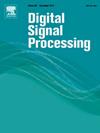基于可重构智能曲面的近场跟踪性能限制与相位设计
IF 2.9
3区 工程技术
Q2 ENGINEERING, ELECTRICAL & ELECTRONIC
引用次数: 0
摘要
定位与跟踪技术是信号处理领域的关键技术之一。传统的方法采用基于距离的技术进行目标定位和跟踪,但当视线(LOS)链路受阻时,算法的精度会下降甚至失效。可重构智能表面(RIS)作为一种低成本、可灵活部署的硬件材料,可以定向反射输入信号,提供额外的虚拟视线(VLOS)链路,以提高目标定位和跟踪的精度。本文研究了基于RIS的近场目标跟踪问题,分析了该场景下RIS的性能极限,并设计了RIS的相位。具体而言,我们建立了一个近场ris辅助跟踪系统的场景,并推导了后验cram本文章由计算机程序翻译,如有差异,请以英文原文为准。
Performance limit and phase design for near-field tracking with reconfigurable intelligent surface
Localization and tracking technique is one of the key technologies in the field of signal processing. Traditional methods use range-based techniques for target localization and tracking, but the algorithm's accuracy can degrade or even fail when the line of sight (LOS) link is obstructed. Reconfigurable intelligent surface (RIS), as a low-cost and flexibly deployable hardware material, can reflect incoming signals in a directional manner, which provides additional virtual line of sight (VLOS) links to enhance the accuracy of target localization and tracking. In this paper, we investigate the near-field target tracking problem with RIS, while analyzing the performance limit for the scenario and designing the phase of the RIS. Specifically, we establish a scene of near-field RIS-assisted tracking system and derive the posterior Cramér-Rao lower bound (PCRLB) as the tracking performance metric. By handling the Fisher information matrix (FIM), we illustrate that RIS-assisted target tracking system can effectively reduce the blind spot range of target velocity estimation compared to the traditional antenna array. Furthermore, we formulate an optimization problem by minimizing PCRLB to seek the optimal phase design under two scenes. For the prior target scenario, we process the original problem as a semidefinite program (SDP) problem by releasing it. In the unknown target scenario, we process the area of interest into an uncertain set and ultimately solve the problem through robust alternating optimization. Finally, the simulation experiments prove the effectiveness of the RIS-assisted target tracking algorithm.
求助全文
通过发布文献求助,成功后即可免费获取论文全文。
去求助
来源期刊

Digital Signal Processing
工程技术-工程:电子与电气
CiteScore
5.30
自引率
17.20%
发文量
435
审稿时长
66 days
期刊介绍:
Digital Signal Processing: A Review Journal is one of the oldest and most established journals in the field of signal processing yet it aims to be the most innovative. The Journal invites top quality research articles at the frontiers of research in all aspects of signal processing. Our objective is to provide a platform for the publication of ground-breaking research in signal processing with both academic and industrial appeal.
The journal has a special emphasis on statistical signal processing methodology such as Bayesian signal processing, and encourages articles on emerging applications of signal processing such as:
• big data• machine learning• internet of things• information security• systems biology and computational biology,• financial time series analysis,• autonomous vehicles,• quantum computing,• neuromorphic engineering,• human-computer interaction and intelligent user interfaces,• environmental signal processing,• geophysical signal processing including seismic signal processing,• chemioinformatics and bioinformatics,• audio, visual and performance arts,• disaster management and prevention,• renewable energy,
 求助内容:
求助内容: 应助结果提醒方式:
应助结果提醒方式:


